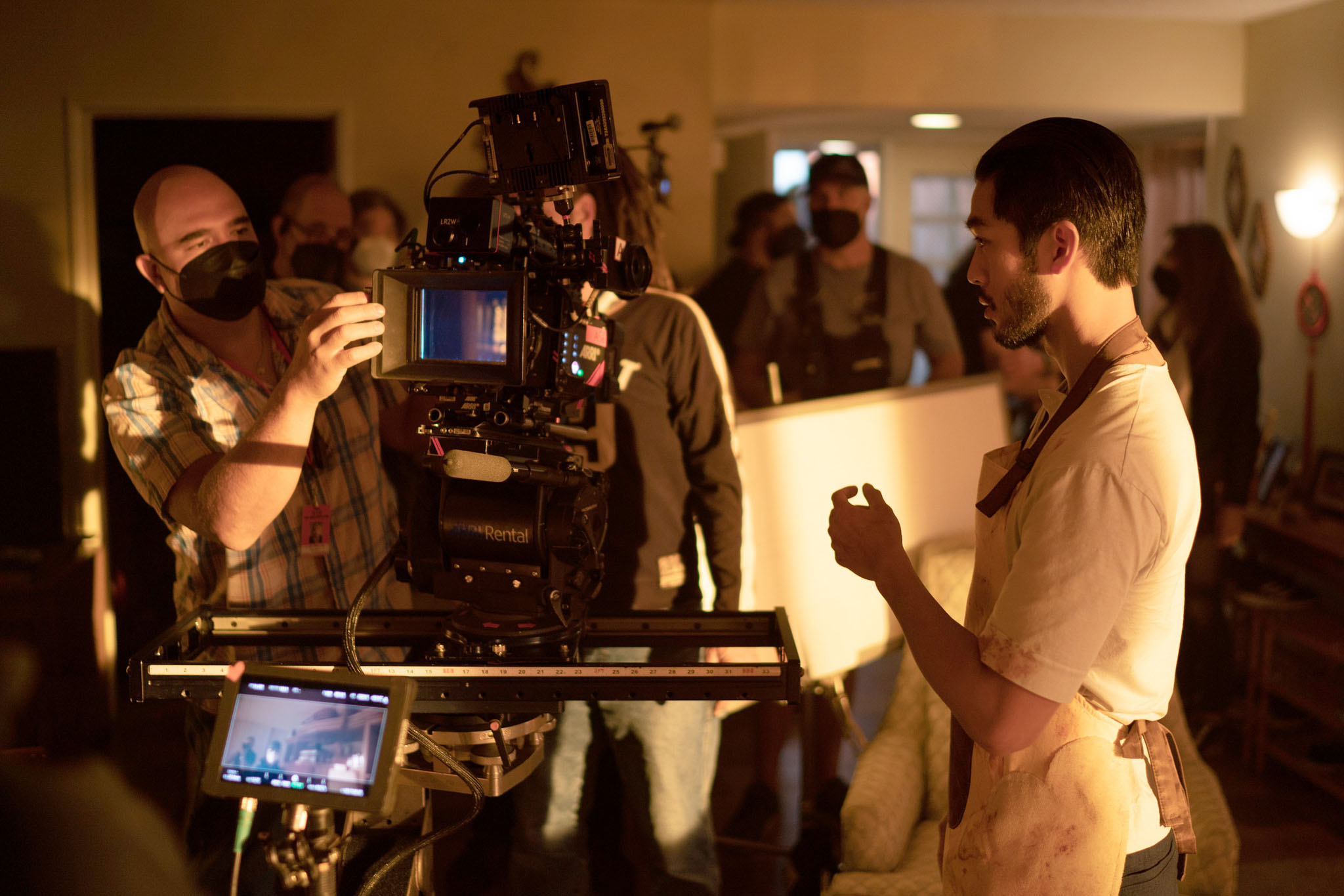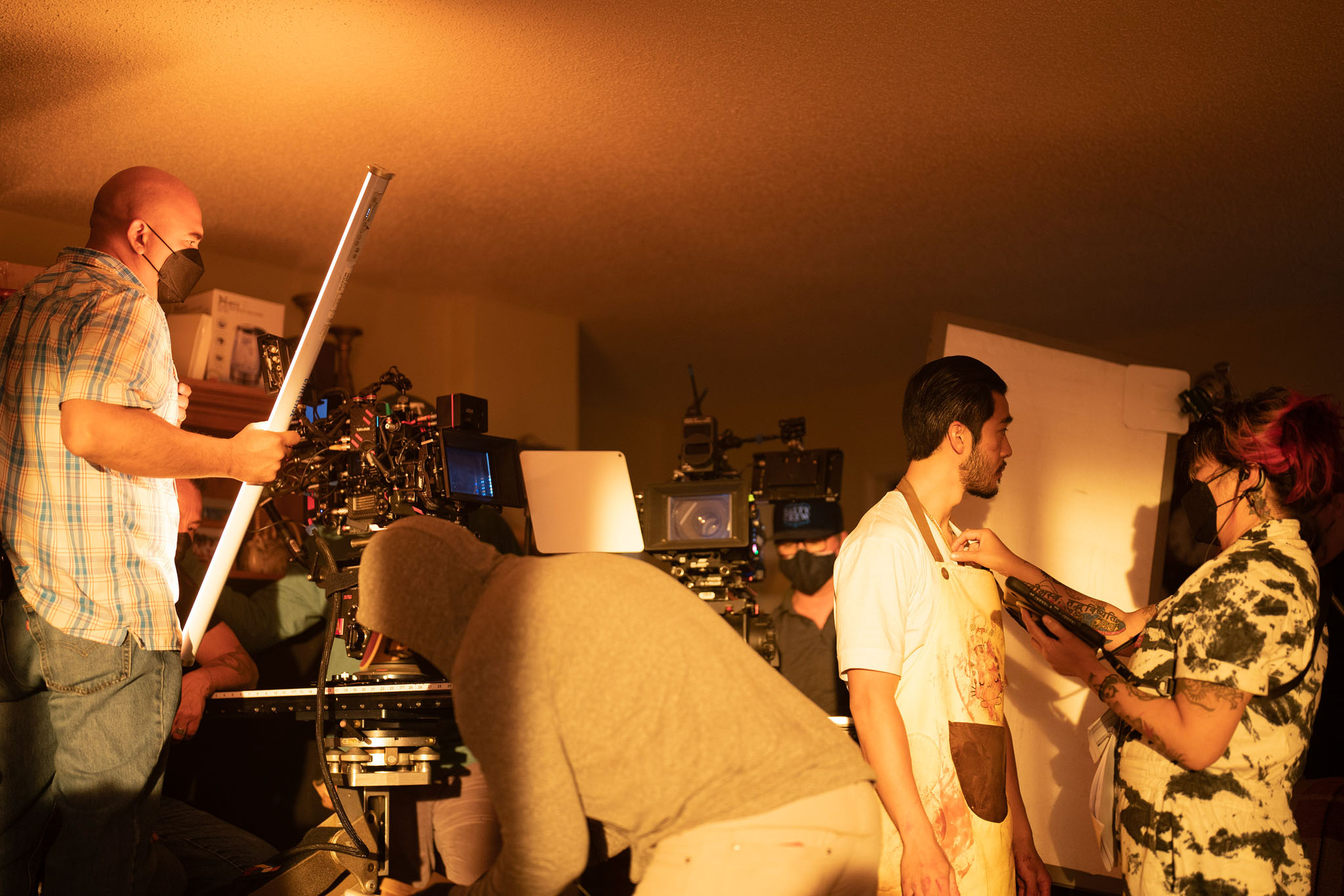
C. Kim Miles, ASC, CSC adjusting VariCon and Justin Chien as Charles Sun in The Brothers Sun. Photo: Michael Desmond/Netflix © 2023.
Going into The Brothers Sun, you might have imagined the studio pitch that sold it: “Michelle Yeoh is the star—it’s Sons of Crouching Tiger meet Everything Everywhere and Crazy Rich Triads.” The opening sequence of this Netflix gangster series quickly dispels any preconceptions. But we’re here to discuss cinematography, not spoilers, with C. Kim Miles, ASC, who did 5 episodes. (Andrew Mitchell did 3 episodes.)
Jon Fauer: How did you get into film?
C. Kim Miles: My best friend in Malaysia, all through school from the time we were three years old, was the son of a couple that owned a commercial production company there. After high school, we had some time off before college, and he said, why don’t you come be a grip, come work at mom and dad’s place. I grew up in Malaysia and moved to Canada in 1990.
When did you start on The Brothers Sun?
We started prep around April 2022, went to camera around the middle of June and ran until October. For all of the ambition in the show, it was pretty tight. But we got all the tools that we needed to tell the story.
Tell us about those tools to tell the story: cameras, cameras, lenses and lights.
We tested cameras, knowing there would be a lot of scenes at night. We decided to go with the ALEXA Mini LF because it looked so good, even exposing at 3,200 ISO. We used two different sets of lenses on the show to delineate between Taiwan and Los Angeles. The edict was to give Taiwan a very slick, modern feel, and to give Los Angeles a dustier San Gabriel Valley sensibility. So, we were on Signature Primes when we were shooting Taiwan or Taipei, and on ARRI DNA Primes in Los Angeles. We ended up re-tuning the DNA Primes to return them back to a neutral, cleaner look. We didn’t want to get into trouble with visual effects, and we knew that the pacing of the show wasn’t going to allow us to mess around too much with parts of the lens that might cause problems.
What rental house supplied the camera and lens package?
ARRI Rental has been my go-to rental house for many years. They’ve been very supportive of my work. One of things they were developing came into play on this show: a new version of the VariCon variable contrast filter. (Others are also doing it.) Instead of just fogging the entire frame, this one surrounds the frame with 64 separate LEDs that are RGBW and fully controllable. It goes in the filter tray of the mattebox and edge-lights the filter. We can either tint the entire frame or control it selectively to just a little corner or a little highlight here and there. The new version that we’re using on the show I’m doing right now allows us to separate the LEDs into two separate little clumps. We can put a warm wash in the top of the frame and a cool wash in the bottom of the frame to give it some color separation. So that was something that I knew I wanted to work with on The Brothers Sun and was a big reason for choosing ARRI Rental.
(The original Lightflex was developed by Gerry Turpin, BSC around 1972 and used by Freddie Francis, BSC on The French Lieutenant’s Woman and other films. It had hot quartz bulbs and was the size of a teleprompter. ARRI Inc President Volker Bahnemann hired Stan Loth in New York and they developed it into the original VariCon in the 1980s to fit into two filter slots of a 6.6×6.6 mattebox. -JF)
Your Taiwan sequences sparkled beautifully.
The Signature Primes were real-world perfect. They’re beautiful on skin tones. They’re sharp, edge to edge. The contrast is not too contrasty, but they’re not flat. The focus fall-off is nicely rounded.
By comparison, our ARRI DNA Primes are softer, with less contrast and have a somewhat less than perfect aberration and veiling flares that can go all over the frame. The DNA Primes are more eclectic. Each one has its own personality, different from the others. While they’re a set that works well together, each one is individual. They take flares in a more old school way. They tend to veil really quickly if hard light hits the front elements. But, they’re not so imperfect that you get into trouble with them. They don’t create chromatic aberration. They don’t have weird magenta or green fringing on the edge of frame. They don’t bend the edges. They’re all around good performers. Being able to tune them is fun, although we didn’t do that on this show. Also, because the DNA lenses tend to fall off pretty quickly when they’re wide open, I rarely opened up more than T2.8 unless we were after a particularly shallow depth to field.
Most of our DNAs were LF DNAs, the second generation. But we did have a few of the original ALEXA 65 DNA Primes, including a 65mm portrait lens and a 35mm.
The big fight in the kitchen of Mama’s house before she comes home has a bright orange sodium street streetlight outside the kitchen window and green cyan moonlight. You’ll see some extended use of VariCon blue flares in the bottom edge of frame.
Did you have multiple cameras for the fight sequences?
Yes, two or three cameras. The fight choreographers worked on John Wick, so they knew their stuff.
Were the dialogue scenes single camera or multiple?
The B camera played quite a bit, about 50% of the time. It usually comes down to schedule and time of day and when we’ve got to get through a scene. That’s when the B camera comes out.
Do you operate yourself?
I do, but I like to be with the director and observe the actors during the take. I have a Preston Wireless Hand Unit with me all the time for iris control so I can make exposure adjustments on the fly if needed.
Did you establish show LUTs in pre-production?
Yes. We had a LUT for Taiwan and a LUT for Los Angeles. I usually try to run some tests early on and build LUTs with my favorite colorist Maxine Gervais at Picture Shop. Then we adapt those LUTs to our particular circumstances on set with CDLs from shot to shot. I try not to do that too much because it can wreak havoc in post when they have to track too many CDLs. But sometimes when shooting, it’s a choice of option A, “Let’s wait 10 minutes while we bring in another fill light,” or option B “Let’s lift the midtones in the CDL.” Option B often wins when we’re under the gun.
You were there for the grading, I trust?
Absolutely. That’s one of the most critical things for me. Otherwise, it’s like telling a photographer that we’ll hire you for the photos, but we’re going to control the Photoshop work afterwards.
What aspect ratio did you work in?
We’re 2.39:1 spherical widescreen. We recorded ALEXA LF Open Gate with 2.39:1 framelines. We usually put a 95% frame line up, so there’s a bit of look-around if they need to stabilize in post. Visual effects need a bit more info, and that is why we recorded the entire frame, full height. It’s cropped in post. We shoot a rack leader at the beginning to match our frame lines.
Theoretically you could crop in camera?
Yes, you can record in 2.39:1 sensor mode. You might save a bit of data consumption, but the downside is that you remove a lot of insurance for repositioning and visual effects. But, on average, we used two data cards in a day. So, data is not really an issue.
How did you rate the cameras at night?
Often, we’d be at 1600 ISO to expose at T2.8 on the lens. It holds up really well with the LF sensor.
With all the fight scenes where your camera is moving around, often at night, you had a very good focus puller.
Raymond Milazzo is awesome. He also had a Preston Light Ranger mounted on the camera.
Were you handheld or on Steadicam for the fight scenes?
Mostly remote head. We wanted to take the Jackie Chan approach to fight choreography. He explains that the difference between Hong Kong and Hollywood fight sequences is in the choreography. If you’re cutting around the hits, you’re missing all the intricacy that you see in the wide shots of the Hong Kong style. So we tried to stay back on remote heads and Steadicam.
What did you use for lighting?
As much as I like LEDs and the options that they offer you with color correction on set, I still like big sources coming through windows. I like 20Ks and T12s pounding through windows, PAR cans making hot streaks on the floor. I use a lot of tungsten sources on stage. Oh, okay. And then we round it out with modern fixtures like SkyPanels, Creamsource Vortex, Astera Titan and Helios tube fixtures. The tubes are completely self-contained, battery powered, RGB—so you can make them any color you want. The Titans are 4-feet long, so if you put them horizontally, you get enough of a wrap onto an actor’s face that it doesn’t feel like a single source. It feels global.

The Brothers Sun. (L to R) Director of Photography C. Kim Miles, Justin Chien as Charles Sun in episode 102 of The Brothers Sun. Photo: Michael Desmond/Netflix © 2023








